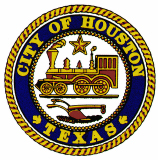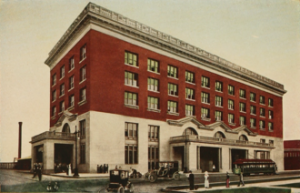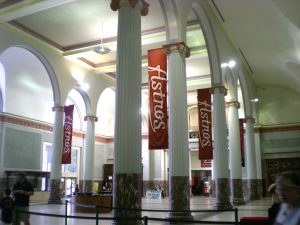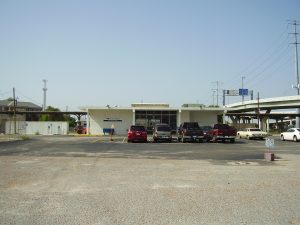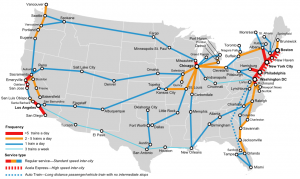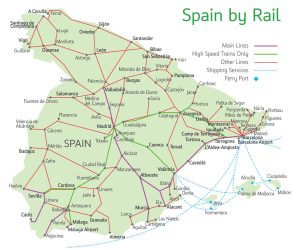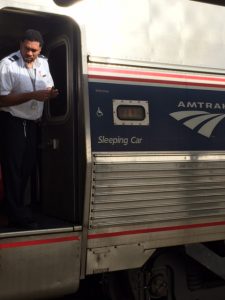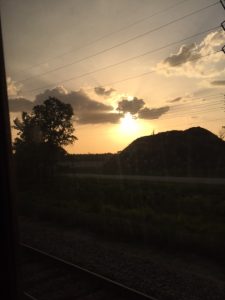In the idea phase of our cross-country train trip, we had it in mind to go from Tampa-St. Pete to Houston, where our daughter and son-in-law live. Inter-city travel is why trains were invented, right? We knew Amtrak wasn’t on a par with Europe’s anywhere-to-anywhere rail services, but surely it could get us to the 4th largest city in the United States without too much hassle.
Or not.
Houston’s Union Station was dedicated in 1911. At that time, the city had 17 railways and was considered the primary rail hub for the southern United States – as evidenced by the locomotive prominently displayed on its official Seal.
An architectural beauty in the Classical Revival style, the station has an exterior of granite, limestone, and terracotta,
and an interior filled with Texas steel and Belgian red marble. In its article on the dedication, the Houston Chronicle said:
The Houston Union Station is significant of the city’s confidence in its own future. It is the gateway through which the millions who enter and leave this city in years to come will pass directly to or from the centers of trade.”
“Years to come” turned out to be seven decades: four strong ones, followed by three on the wane. The station went out of business in 1974, when Amtrak discontinued the last regularly-scheduled train – the Lone Star, serving Chicago, Kansas City, Oklahoma City, Fort Worth, Houston, and points between – and shifted all remaining service to tiny Houston Station. In 1977, Union Station was added to the National Register of Historic Places. About twenty years later, in a rather odd sequence of twists, it was appropriated by Enron Chairman Kenneth Lay, who renovated the entire place with due attention to its historical status and reopened it as Enron Field (now Minute Maid Park), home of the Houston Astros.
While baseball fans enjoy the opulent splendor of the original Union Station, Amtrak passengers make do with this:
Only one train stops at Houston Station. The Sunset Limited runs three times a week from New Orleans to Los Angeles and three times a week back again. The west-bound arrives in Houston on Mon/Wed/Sat evenings. The east-bound, a double over-nighter, hits Houston Tues/Thurs/Sun around midday.
As the map below indicates, there is no train service direct from Florida to Louisiana. All Tampa-to-New Orleans routes require three days of travel, two nights on a train, various combinations of transport (buses and trains), and at least four connections. The most efficient travel plan option is, in fact, an hellacious route: trains from Tampa to DC to Chicago to Dallas, and then a 4-5 hour bus ride from Dallas to Houston.
In the end, we scratched Houston off the itinerary. Getting there and getting out of there via Amtrak was prohibitively inconvenient.
Check the key on the route-map above (click on any pic to enlarge it), and you’ll see that most of the big cities Amtrak serves only get service once a day. Some get less. Note also how few routes interconnect. There are only three major rail hubs in the entire country: Sacramento, Chicago, and Washington, D.C. If you want to do anything fancy – like visiting Houston, Kansas City, and Denver on your way to California – you must either continually return to Chicago to swap trains and/or resign yourself to some long-ass bus rides.
Just for fun, use the maps above and below to compare Amtrak’s passenger train service to Renfe’s (Spain’s national railway). Bear in mind that the United States is about 19 times bigger than Spain, and that none of the US routes are high-speed rail.
As I indicated in Riding the Rails – A Primer, it’s folly to be in a hurry when you’re travelling by train. With the exception of a few high-use commuter lines, trains rarely run on time. The take-away from this blog-post: it’s equally foolish to assume a train can get you where you want to go. Yes, you’ll reach your desired destination, but using Amtrak may add a day or two to your journey, and you’ll probably arrive by coach.
According to their website, Amtrak serves 500 destinations in 46 states. Even taking Hawaii and Alaska out of the equation (and really, Alaska should be in the equation), that leaves two states and a full 97.5% of the USA’s approximately 20,000 cities and metropolitan areas with no Amtrak service whatsoever. San Francisco, Phoenix, Las Vegas, Columbus, Nashville, and Louisville – all with populations of more than 1 million – have Amtrak bus stations only.
So, how does one zig-zag across this country? Not by air, certainly. Non-stop direct flights are everyone’s preference; multiple flights on commercial airlines would be horribly uncomfortable and hugely expensive. Hopping on and off a train is a great way to travel – if there is a single train that stops all the places you want to go. Hopping off a train and onto another train is a time-sensitive crapshoot.
Waiting on the platform, watching the Silver Star back into the station (it’s a weird feature of Tampa’s Union Station that it is located off the main track, essentially on a sideline; arriving trains have to pass it by, stop, and then enter in reverse), I wasn’t just excited about our next destination. I was excited about getting back on the train. The romance of train travel was sweetly scenting the hot, muggy air. We weren’t in any particular hurry. We had no connections to make. And having quite enjoyed riding the Star south to Tampa, we were looking forward to riding it north to DC.
When you book a sleeper or roomette on Amtrak, meals are included. Only catch, not all trains have dining cars. Superliners, yes. Viewliners like the Silver Star, no. Some things are still complimentary for sleeper-passengers (waters, coffee/tea, orange juice). And there is a snack bar with coffee, tea, sodas, juices, waters to drink and microwaveable or pre-packaged mini-meals, chips, cookies, candy bars, nuts, and other convenience store type foods to eat. We’d been ok on the way down, thanks to our small stash of healthy snack-bars. We figured a plain bagel and cream cheese or hummus for brekkers would do in a pinch, but this time we came aboard not only with snack-bars, but with a giant bag of trail mix and an assortment of fresh fruit.
We’d also come aboard more prepared to deal with our tiny quarters. Everything we both needed for an over-night was in one bag; the other could stay closed. Soon as we hit the roomette, we lowered the upper bunk, intending to store the cases there till later. I hopped up to help haul the bags into position . . . and that’s when I saw the storage compartment in the wall to the left of the mirror. The storage compartment we’d entirely missed on the way down. The storage compartment that was big enough to hold both suitcases and some small items. Yes, it was still handy to have everything in one case, but we felt like total idiots for having missed it before.
Of all the trains and all the train rides we took on this trip, heading north on the Silver Star was my favorite. This leg of the journey, and this leg alone, conjured the feeling I’d had when I’d toured northwestern Europe on a EurRail Pass back in 1979 – the feeling of being at home on the road. Our two tidy bags were neatly tucked away. All of our day-use and over-night items were slotted perfectly into their own little nooks or hanging discreetly from their own little hooks. All our necessities were accessible, and everything we had was a necessity. No clutter, no excess; we were travelling light.
Sitting across from each other, he read, I wrote. We watched the states go by.
Having wisely worn no-hassle, small-space appropriate clothes onto the train, all I had to do to be ready for bed was slip out of my skirt. With no suitcases to block my way, climbing up and down from my bunk was no problem at all. My reading light out, my upper curtain open, the Silver Star rocking and rolling gently along, I lay awake a while. Watching the magic-tinged world outside hurtling by . . .
. . . I felt blessed by the Gods who watch over travellers, and poetically inspired.

